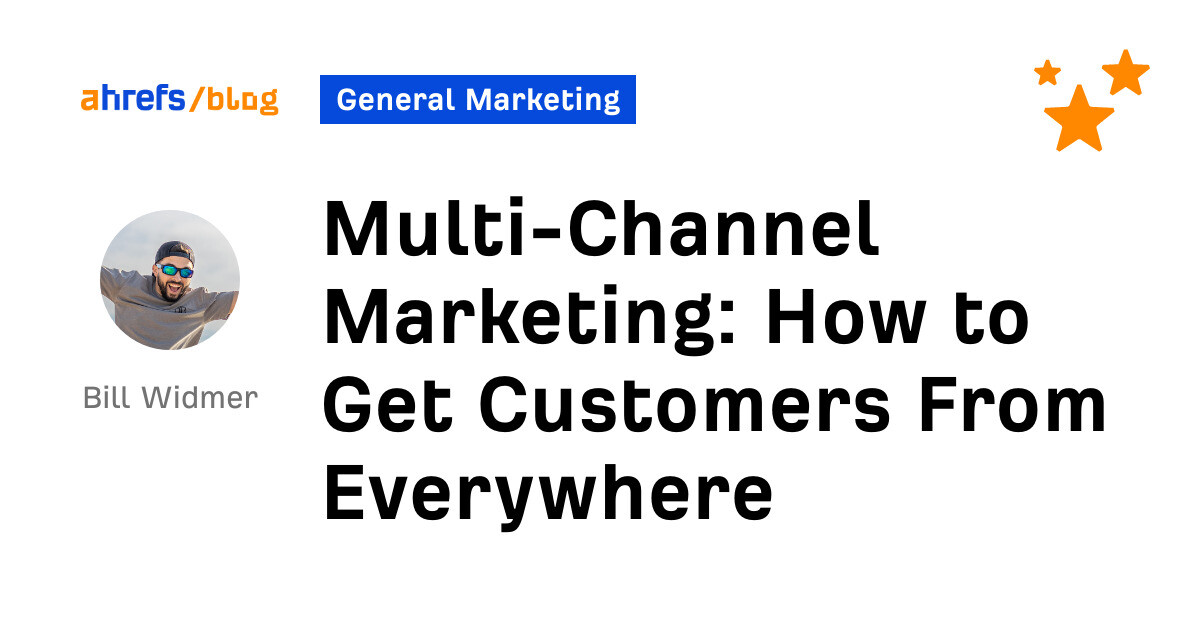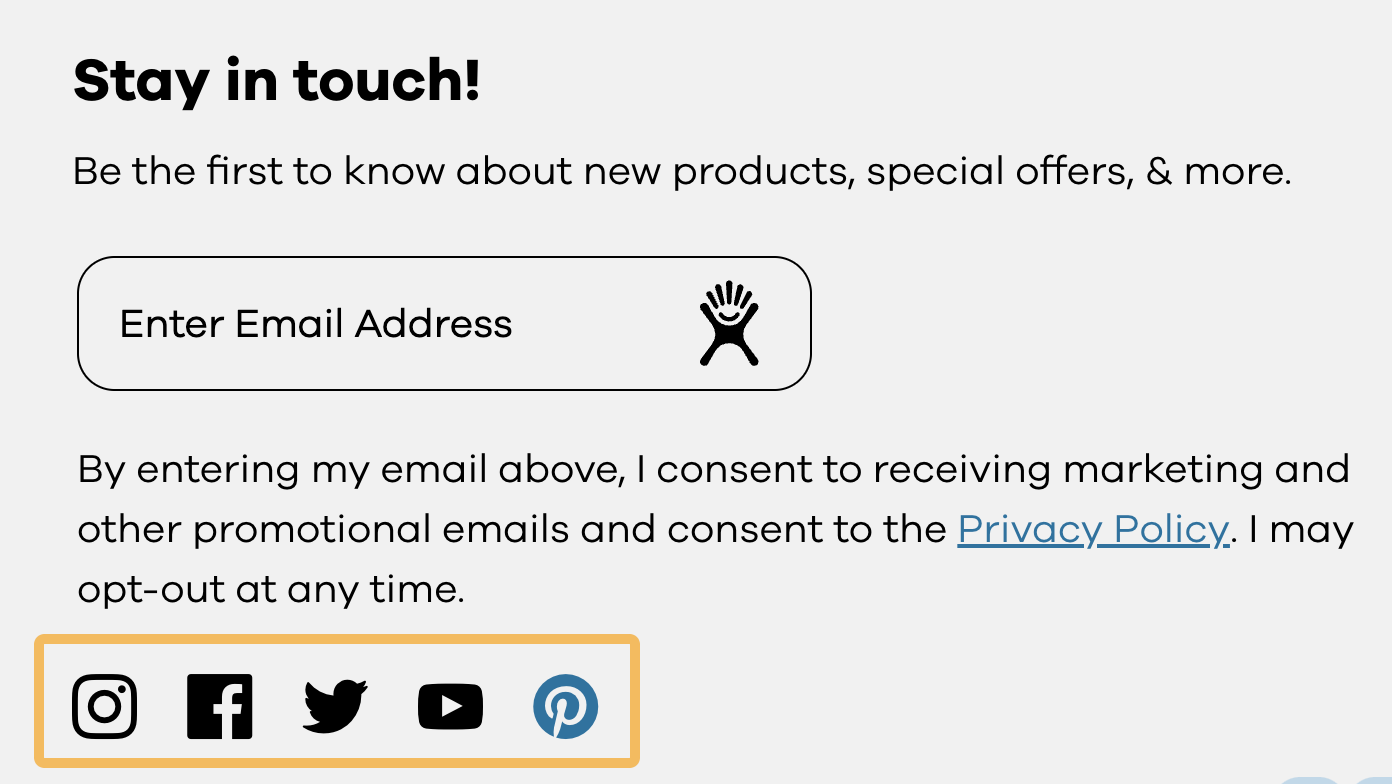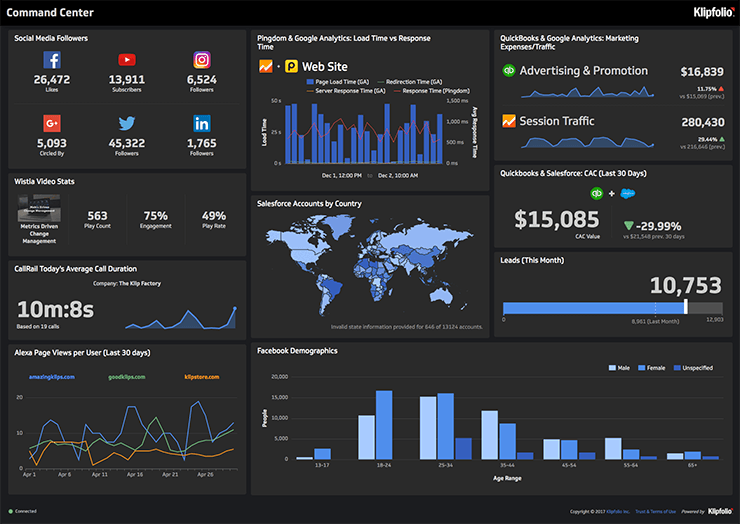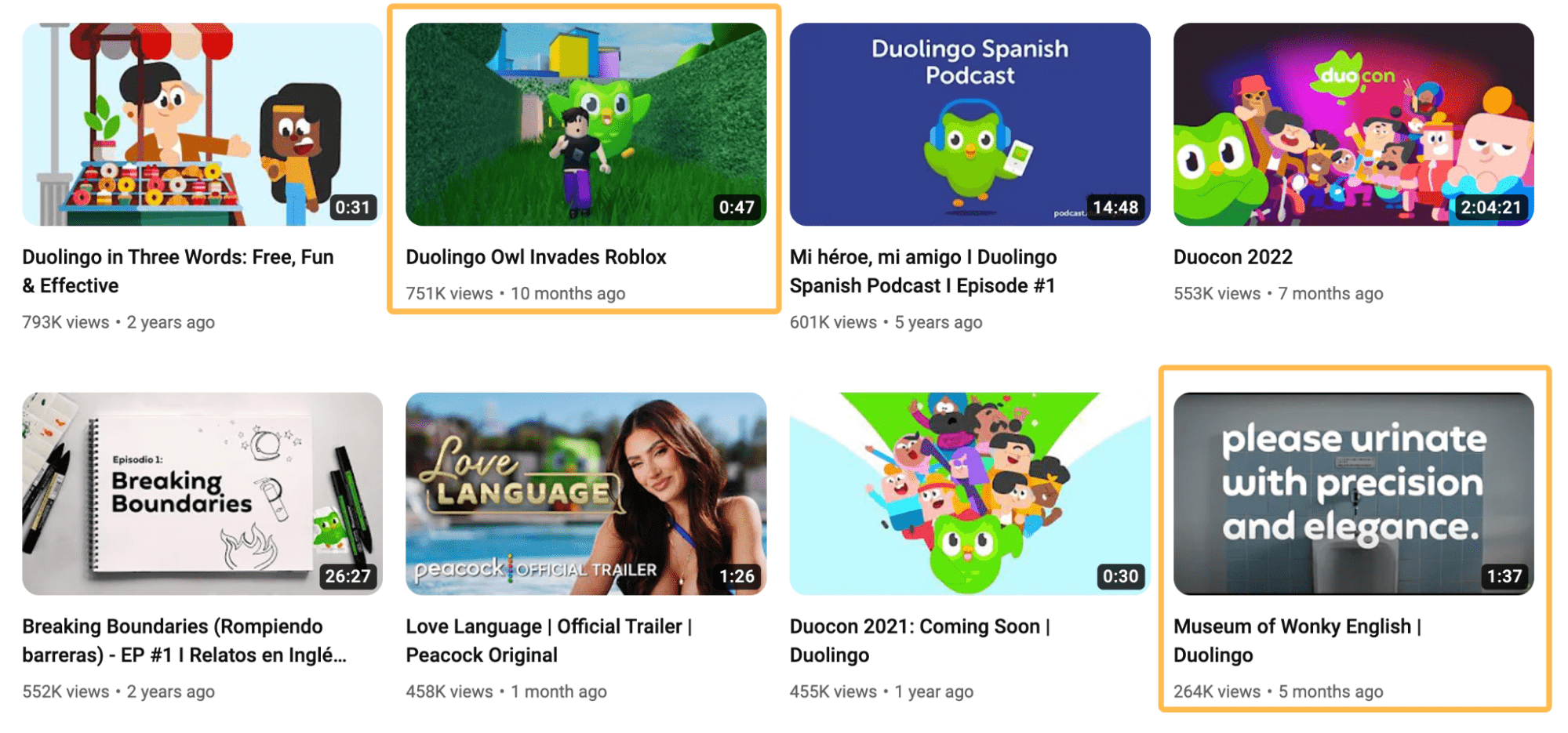SEO
How to Get Customers From Everywhere

Traffic, leads, sales—the more you get, the better. Having a singular focus on one marketing strategy can bear fruit but almost always reaches a cap. That’s where multi-channel marketing comes in.
If you want to maximize sales and minimize marketing costs, a multi-channel approach can help you capture customers you may otherwise never reach.
But what is multi-channel marketing, really? And how do you do that while staying organized? Let’s talk about it.
Multi-channel marketing means utilizing multiple channels to get your brand in front of potential customers. This can mean using a combination of SEO, social media marketing, paid advertising, and any number of other marketing channels.
The benefits of multi-channel marketing
As I alluded to above, multi-channel marketing allows you to reach more customers than a single-channel focus ever can. To illustrate, some people will never search for the keywords you rank for on Google, and some people just don’t use social media.
In addition to a broader reach, you may be able to capture new customers for a lower cost.
Case in point: Organic social media is free, and spreading your advertising over a mix of both social channels and paid search engine marketing means you’ll find the most effective use of your ad spend. This will allow you to spend only on what’s working and avoid wasted ad spend.
The challenges of marketing on multiple channels
Of course, having more channels results in more complexity.
You need to understand how to repurpose your content in order to avoid adding a ton of extra work and expenses.
Not only that, but posting to multiple social media channels on top of doing SEO on your site, managing an email list, and running ads are lots of work—especially if you don’t have a specialized team member to handle each task.
Hiring an entire marketing team is also expensive.
But if you utilize automation software and use a tool to stay organized, you can overcome these challenges without breaking the bank.
Below, I break down the basics of getting started with multi-channel marketing into four steps:
- Establishing consistency across your marketing
- Identifying and researching your target audience
- Choosing the channels you want to add to your marketing strategy
- Using software and tools to stay organized
1. Establish consistency using IMC
If you aren’t careful, utilizing multiple channels and hiring people to manage those channels can quickly lead to inconsistent messaging and branding.
That’s where integrated marketing communications (IMC) comes in.
Strong IMC makes your brand consistent across all the interaction points with customers, from initial awareness of your brand to making a purchase. It includes things like:
- Brand styling, color, and font guidelines.
- Messaging personality and style (i.e., how your brand writes).
- Approved logo styles.
In other words, you should take the time to create branding and style guidelines for your company. What are your primary colors? How should your logo always appear? What style should your messaging be in, and what’s your mission as a company?
For example, here are Dyno Studio’s style guidelines:

You can see it shows all of the brand’s approved fonts, color combinations, and accepted logo styles. Of course, you can go deeper than that to include your brand’s personality (i.e., how you want your copywriting to come across—witty, funny, silly, serious, or something else).
If you want to learn more about developing brand style guidelines, I highly recommend reading Venngage’s guide here.
2. Identify and research your target audience
One of the most important things you can do to market your company is to understand the audience you’re marketing to. Things like:
- What do they care about?
- What problems do they have that your company can solve?
- Where do they go to find information about your products?
- Etc.
Conducting market research should be a priority. It starts with determining the questions you want to answer. I gave you a few ideas above, but feel free to come up with more of your own.
Once you know what you’re looking for, you need to choose a research method. You can run a survey to your existing customers, ask your customers directly for a phone interview to learn more about them, peruse forums you know your customers use (Reddit is almost always a good bet), or conduct a competitive analysis to see what your competitors are doing.
For example, let’s say I sell high-end water bottles. I know one of my competitors is Hydro Flask. So I take a look at what it’s doing by gathering data on the types of products it’s selling, the price points and features of those products, and any customer reviews.
In particular, I’m trying to figure out what its customers love about the products and what they wish was better about said products.
For example, there are reviews that point to two types of buyers with different needs: (1) someone who needs the insulation for long, hot days at work and (2) someone who bought it as a gift with an engraving for someone else who spends a lot of time on the road:


Digging deeper, we can see a lot of reviews complaining that the bottle leaked. That gives me some information on how to improve my product.

There are also lots of comments mentioning using the bottles for commutes and for the gym, and that helps me improve my picture of the kinds of customers looking for these types of bottles.
But the most important question is this: How did Hydro Flask’s customers find it?
The reviews give a few hints, showing some of its customers bought the product from Dick’s Sporting Goods. However, this doesn’t tell me where I should market my own products.
Looking at its website, I can see it has an email newsletter and is active on Facebook, Twitter, Pinterest, Instagram, and YouTube:

Its best channel seems to be Instagram, with over 600,000 followers. Additionally, it uses brand ambassadors to help promote the products. However, it doesn’t seem to have a blog—which, in my opinion, is a big missed opportunity for it.
Regardless, “spy” on some of your competitors to see which channels they’re using and how they’re using them to inform your own strategy.
3. Choose your channels
You’re now ready to decide which channels to prioritize.
Social media is obvious. You can just have a channel on every major platform (Facebook, Twitter, Instagram) and automate posting across channels with a tool like Buffer.
But not all businesses need all channels. You need to decide if creating videos for TikTok and YouTube is worth your time, as these channels take much more effort.
Also, not every business is suited to have a LinkedIn or Pinterest account. Is your audience using these platforms? If not, they may be worth skipping.
Your other marketing channel options include:
In other words, you’ve got options. Lots of options. Which should you choose?
Well, that depends on what you discovered in the last step. Where is your audience? Do they listen to podcasts? If so, which ones? And what are they searching for on Google? These are questions you need to know the answers to. Go back to the last step if you don’t.
In general, your best bet is to make an account on all the major social media platforms, have a basic email newsletter opt-in on your website, and write blog posts for SEO.
If you aren’t sure where to start, consider plugging competitors’ sites into Ahrefs’ Site Explorer to see what keywords they’re getting traffic from on Google.
For example, let’s say you sell rooftop tents. One of your competitors will be Off Road Tents. If you plug its site into Site Explorer and look at the Organic keywords report, you can see it has blog posts ranking for keywords like “tacoma camper shell” and “tent ac unit”:

This gives you a hint as to what articles are bringing it traffic and, potentially, sales. Read our SEO competitor analysis guide to learn more.
4. Use software to stay organized
Remember how I mentioned one of the drawbacks of a multi-channel approach is how complex and difficult it can be to stay organized and consistent?
Software can help with that.
At Ahrefs, we use Basecamp to track our marketing efforts, keep our writers on the same page, build styling guidelines, and generally stay organized.
It does have a bit of a learning curve compared to other task management software like Asana or Trello, but it is much more capable. It’s up to you which you prefer to use.
Thomas Frank also has many excellent guides that show how to use Notion for content creation, planning, and publishing. Check out his free Notion Fundamentals guide to get started with it.
In addition to using software to stay organized, it also helps to have something like Klipfolio to see all of your analytics across channels in one place. You can keep tabs on your social media stats, advertising success, and so much more in one simple dashboard:

Lastly, content creation and automation tools will become your best friend. These include:
Just remember: These tools are there to make your life less complicated, not more. Try a few, keep what works, and ditch what doesn’t. No need to take on more tools than you require.
Last but not least, let’s take a look at some different approaches to utilizing multiple marketing channels.
Ahrefs
Here at Ahrefs, everything revolves around the product. And that’s what we share across every channel, no matter what. This photo sums it up:

It’s what we talk about here on the blog with tons of educational content. And it’s what we share on social media:
Even our entire YouTube channel is dedicated to teaching you how to use Ahrefs tools to improve your website:

In other words, we stick to our mission of building the best SEO software on the web—regardless of where we’re promoting it.
Duolingo
Duolingo has one of the most fascinating marketing strategies I’ve ever seen. It forgoes focusing on its product in favor of virality and brand recognition.
Just watch one of its TikTok videos, and you’ll see what I mean:
Any idea what its product does based on that video? Yeah, me neither. But that video got 6.4 million views. Its YouTube channel isn’t much different:

It has extremely strong branding through its Duolingo bird mascot, and it combines that with on-trend humor and virality to build brand awareness. It’s also using all the channels available—social, SEO, email, apps, TV, display ads, and more.
Apple
Apple is the king of branding. It utilizes multi-channel marketing better than almost any company that exists, with global recognition of the famous Apple icon.
Like Ahrefs, Apple’s messaging is focused on the product. But instead of educational content, it generates demand through storytelling and evoking emotions.
It uses far more channels than most, mixing older methods such as TV advertising and billboards with unique approaches like offering its own credit card—plus, of course, the usual digital marketing methods of social media, email, and SEO.
Apple is also one of the best examples of integrated marketing communications and a drive to create one, seamless experience across channels and devices it sells.
Unlike the other examples on this list, it mostly utilizes user-generated content (UGC) on its social channels. Nearly all of its posts are reposts from people who use Apple products.

Final thoughts
Multi-channel marketing helps you to get in front of your customers no matter which channels they use. It’s the only way to maximize your brand’s reach.
The main drawbacks—inconsistency and complexity—can be overcome with proper brand style guidelines and by utilizing marketing automation and task management software.
Questions or comments? Ping me on Twitter.
SEO
brightonSEO Live Blog

Hello everyone. It’s April again, so I’m back in Brighton for another two days of Being the introvert I am, my idea of fun isn’t hanging around our booth all day explaining we’ve run out of t-shirts (seriously, you need to be fast if you want swag!). So I decided to do something useful and live-blog the event instead.
Follow below for talk takeaways and (very) mildly humorous commentary. sun, sea, and SEO!
SEO
Google Further Postpones Third-Party Cookie Deprecation In Chrome

Google has again delayed its plan to phase out third-party cookies in the Chrome web browser. The latest postponement comes after ongoing challenges in reconciling feedback from industry stakeholders and regulators.
The announcement was made in Google and the UK’s Competition and Markets Authority (CMA) joint quarterly report on the Privacy Sandbox initiative, scheduled for release on April 26.
Chrome’s Third-Party Cookie Phaseout Pushed To 2025
Google states it “will not complete third-party cookie deprecation during the second half of Q4” this year as planned.
Instead, the tech giant aims to begin deprecating third-party cookies in Chrome “starting early next year,” assuming an agreement can be reached with the CMA and the UK’s Information Commissioner’s Office (ICO).
The statement reads:
“We recognize that there are ongoing challenges related to reconciling divergent feedback from the industry, regulators and developers, and will continue to engage closely with the entire ecosystem. It’s also critical that the CMA has sufficient time to review all evidence, including results from industry tests, which the CMA has asked market participants to provide by the end of June.”
Continued Engagement With Regulators
Google reiterated its commitment to “engaging closely with the CMA and ICO” throughout the process and hopes to conclude discussions this year.
This marks the third delay to Google’s plan to deprecate third-party cookies, initially aiming for a Q3 2023 phaseout before pushing it back to late 2024.
The postponements reflect the challenges in transitioning away from cross-site user tracking while balancing privacy and advertiser interests.
Transition Period & Impact
In January, Chrome began restricting third-party cookie access for 1% of users globally. This percentage was expected to gradually increase until 100% of users were covered by Q3 2024.
However, the latest delay gives websites and services more time to migrate away from third-party cookie dependencies through Google’s limited “deprecation trials” program.
The trials offer temporary cookie access extensions until December 27, 2024, for non-advertising use cases that can demonstrate direct user impact and functional breakage.
While easing the transition, the trials have strict eligibility rules. Advertising-related services are ineligible, and origins matching known ad-related domains are rejected.
Google states the program aims to address functional issues rather than relieve general data collection inconveniences.
Publisher & Advertiser Implications
The repeated delays highlight the potential disruption for digital publishers and advertisers relying on third-party cookie tracking.
Industry groups have raised concerns that restricting cross-site tracking could push websites toward more opaque privacy-invasive practices.
However, privacy advocates view the phaseout as crucial in preventing covert user profiling across the web.
With the latest postponement, all parties have more time to prepare for the eventual loss of third-party cookies and adopt Google’s proposed Privacy Sandbox APIs as replacements.
Featured Image: Novikov Aleksey/Shutterstock
SEO
How To Write ChatGPT Prompts To Get The Best Results

ChatGPT is a game changer in the field of SEO. This powerful language model can generate human-like content, making it an invaluable tool for SEO professionals.
However, the prompts you provide largely determine the quality of the output.
To unlock the full potential of ChatGPT and create content that resonates with your audience and search engines, writing effective prompts is crucial.
In this comprehensive guide, we’ll explore the art of writing prompts for ChatGPT, covering everything from basic techniques to advanced strategies for layering prompts and generating high-quality, SEO-friendly content.
Writing Prompts For ChatGPT
What Is A ChatGPT Prompt?
A ChatGPT prompt is an instruction or discussion topic a user provides for the ChatGPT AI model to respond to.
The prompt can be a question, statement, or any other stimulus to spark creativity, reflection, or engagement.
Users can use the prompt to generate ideas, share their thoughts, or start a conversation.
ChatGPT prompts are designed to be open-ended and can be customized based on the user’s preferences and interests.
How To Write Prompts For ChatGPT
Start by giving ChatGPT a writing prompt, such as, “Write a short story about a person who discovers they have a superpower.”
ChatGPT will then generate a response based on your prompt. Depending on the prompt’s complexity and the level of detail you requested, the answer may be a few sentences or several paragraphs long.
Use the ChatGPT-generated response as a starting point for your writing. You can take the ideas and concepts presented in the answer and expand upon them, adding your own unique spin to the story.
If you want to generate additional ideas, try asking ChatGPT follow-up questions related to your original prompt.
For example, you could ask, “What challenges might the person face in exploring their newfound superpower?” Or, “How might the person’s relationships with others be affected by their superpower?”
Remember that ChatGPT’s answers are generated by artificial intelligence and may not always be perfect or exactly what you want.
However, they can still be a great source of inspiration and help you start writing.
Must-Have GPTs Assistant
I recommend installing the WebBrowser Assistant created by the OpenAI Team. This tool allows you to add relevant Bing results to your ChatGPT prompts.
This assistant adds the first web results to your ChatGPT prompts for more accurate and up-to-date conversations.
It is very easy to install in only two clicks. (Click on Start Chat.)
For example, if I ask, “Who is Vincent Terrasi?,” ChatGPT has no answer.
With WebBrower Assistant, the assistant creates a new prompt with the first Bing results, and now ChatGPT knows who Vincent Terrasi is.
 Screenshot from ChatGPT, March 2023
Screenshot from ChatGPT, March 2023You can test other GPT assistants available in the GPTs search engine if you want to use Google results.
Master Reverse Prompt Engineering
ChatGPT can be an excellent tool for reverse engineering prompts because it generates natural and engaging responses to any given input.
By analyzing the prompts generated by ChatGPT, it is possible to gain insight into the model’s underlying thought processes and decision-making strategies.
One key benefit of using ChatGPT to reverse engineer prompts is that the model is highly transparent in its decision-making.
This means that the reasoning and logic behind each response can be traced, making it easier to understand how the model arrives at its conclusions.
Once you’ve done this a few times for different types of content, you’ll gain insight into crafting more effective prompts.
Prepare Your ChatGPT For Generating Prompts
First, activate the reverse prompt engineering.
- Type the following prompt: “Enable Reverse Prompt Engineering? By Reverse Prompt Engineering I mean creating a prompt from a given text.”
 Screenshot from ChatGPT, March 2023
Screenshot from ChatGPT, March 2023ChatGPT is now ready to generate your prompt. You can test the product description in a new chatbot session and evaluate the generated prompt.
- Type: “Create a very technical reverse prompt engineering template for a product description about iPhone 11.”
 Screenshot from ChatGPT, March 2023
Screenshot from ChatGPT, March 2023The result is amazing. You can test with a full text that you want to reproduce. Here is an example of a prompt for selling a Kindle on Amazon.
- Type: “Reverse Prompt engineer the following {product), capture the writing style and the length of the text :
product =”
 Screenshot from ChatGPT, March 2023
Screenshot from ChatGPT, March 2023I tested it on an SEJ blog post. Enjoy the analysis – it is excellent.
- Type: “Reverse Prompt engineer the following {text}, capture the tone and writing style of the {text} to include in the prompt :
text = all text coming from https://www.searchenginejournal.com/google-bard-training-data/478941/”
 Screenshot from ChatGPT, March 2023
Screenshot from ChatGPT, March 2023But be careful not to use ChatGPT to generate your texts. It is just a personal assistant.
Go Deeper
Prompts and examples for SEO:
- Keyword research and content ideas prompt: “Provide a list of 20 long-tail keyword ideas related to ‘local SEO strategies’ along with brief content topic descriptions for each keyword.”
- Optimizing content for featured snippets prompt: “Write a 40-50 word paragraph optimized for the query ‘what is the featured snippet in Google search’ that could potentially earn the featured snippet.”
- Creating meta descriptions prompt: “Draft a compelling meta description for the following blog post title: ’10 Technical SEO Factors You Can’t Ignore in 2024′.”
Important Considerations:
- Always Fact-Check: While ChatGPT can be a helpful tool, it’s crucial to remember that it may generate inaccurate or fabricated information. Always verify any facts, statistics, or quotes generated by ChatGPT before incorporating them into your content.
- Maintain Control and Creativity: Use ChatGPT as a tool to assist your writing, not replace it. Don’t rely on it to do your thinking or create content from scratch. Your unique perspective and creativity are essential for producing high-quality, engaging content.
- Iteration is Key: Refine and revise the outputs generated by ChatGPT to ensure they align with your voice, style, and intended message.
Additional Prompts for Rewording and SEO:
– Rewrite this sentence to be more concise and impactful.
– Suggest alternative phrasing for this section to improve clarity.
– Identify opportunities to incorporate relevant internal and external links.
– Analyze the keyword density and suggest improvements for better SEO.
Remember, while ChatGPT can be a valuable tool, it’s essential to use it responsibly and maintain control over your content creation process.
Experiment And Refine Your Prompting Techniques
Writing effective prompts for ChatGPT is an essential skill for any SEO professional who wants to harness the power of AI-generated content.
Hopefully, the insights and examples shared in this article can inspire you and help guide you to crafting stronger prompts that yield high-quality content.
Remember to experiment with layering prompts, iterating on the output, and continually refining your prompting techniques.
This will help you stay ahead of the curve in the ever-changing world of SEO.
More resources:
Featured Image: Tapati Rinchumrus/Shutterstock
-

 PPC6 days ago
PPC6 days ago19 Best SEO Tools in 2024 (For Every Use Case)
-

 MARKETING7 days ago
MARKETING7 days agoEcommerce evolution: Blurring the lines between B2B and B2C
-
SEARCHENGINES5 days ago
Daily Search Forum Recap: April 19, 2024
-
SEARCHENGINES6 days ago
Daily Search Forum Recap: April 18, 2024
-

 WORDPRESS6 days ago
WORDPRESS6 days agoHow to Make $5000 of Passive Income Every Month in WordPress
-

 SEO7 days ago
SEO7 days ago2024 WordPress Vulnerability Report Shows Errors Sites Keep Making
-

 WORDPRESS6 days ago
WORDPRESS6 days ago10 Amazing WordPress Design Resouces – WordPress.com News
-

 SEO6 days ago
SEO6 days ago25 WordPress Alternatives Best For SEO















